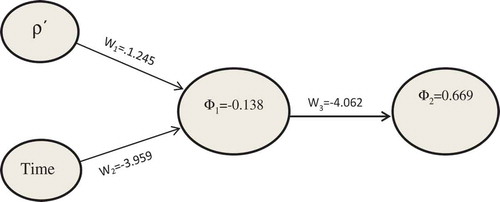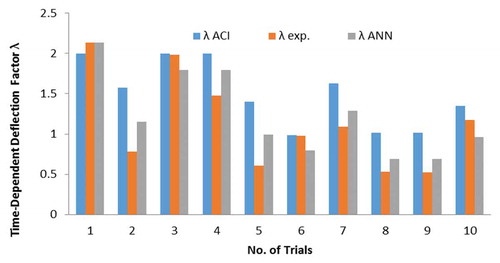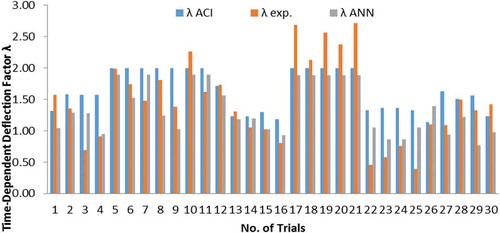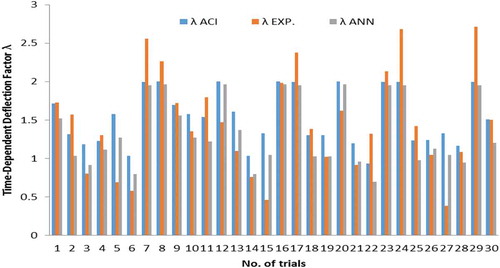 ?Mathematical formulae have been encoded as MathML and are displayed in this HTML version using MathJax in order to improve their display. Uncheck the box to turn MathJax off. This feature requires Javascript. Click on a formula to zoom.
?Mathematical formulae have been encoded as MathML and are displayed in this HTML version using MathJax in order to improve their display. Uncheck the box to turn MathJax off. This feature requires Javascript. Click on a formula to zoom.Abstract
The architecture and weights of an artificial neural network model that predicts time-dependent deflection have been developed and optimized. To satisfy the serviceability limit states, a concrete structure must be serviceable and perform its intended function throughout its working life. Excessive deflection should not impair the function of the structure or be aesthetically unacceptable. Cracks should not be unsightly or wide enough to lead to durability problems. Design for the serviceability limit states involves making reliable predictions of the instantaneous and time-dependent deflection of reinforced concrete beams. This is complicated by the nonlinear behavior of concrete caused mainly by cracking, tension stiffening, creep, and shrinkage. This paper provides a statistical approach for predicting the time-dependent deflection of reinforced concrete beams at service loads and outlines a validity of the proposed method in comparison with the American Concrete Institute (ACI) method.
PUBLIC INTEREST STATEMENT
The application of artificial neural network (ANN) systems is growing rapidly in the financial and manufacturing sectors. Neural network systems offer several advantages over traditional methods for predicting the deflection of reinforced concrete beams. Therefore, during the last few years or so, the use of ANNs has increased in many construction engineering problems and has demonstrated some degree of success. ANNs are also being applied to solve problems of structural engineering, where the network is trained on a set of cause–effect data and trained to diagnose the observed effects in terms of unknown causes.
1. Introduction
Owing to the huge importance of time-dependent deflection, satisfactory performance of concrete members should be considered. The calculation of time-dependent deflection for reinforced concrete beams is very convoluted due to several factors that have a significant effect on it, such as the compressive strength of concrete, tension reinforcement, compression reinforcement, the total time of the experiment, the loading history of the structure, and finally creep and shrinkage strain of the concrete. For many years, the main objective of extensive experimental research was the time-dependent deflection of reinforced concrete members. The test selected in this research was made by Gudonis et al. (Citation2015). The study deals with singly reinforced concrete ties to examine experimentally the short- and long-term deflection for a duration of 315 days. Miàs, Torres, Turon, and Barris (Citation2011) experimentally studied the long-term deflection of concrete beams reinforced with Glass Fiber Reinforced bar (GFRP) bars and compared with concrete beams reinforced with steel bars for a duration of 360 days. Gilbert and Nejadi (Citation2004) studied flexural cracking due to the long-term deflection of flexural members under constant sustained service loads and shrinkage strain for a duration of 400 days. Paulson, Nilson, and Hover (Citation1991) studied the long-term deflection of reinforced concrete beams with different compressive strengths for a duration of 360 days, whereas Espion (Citation1988) covered all the experimental research on long-term deflection from 1907 to 1988.
However, there are a number of studies on the prediction of long-term deflection, such as Gholamhoseini (Citation2016), who presented an experimental result for composite slabs subjected to sustained loads and shrinkage to study the long-term deflection and an analytical model to predict the long-term deflection considering the effect of creep and shrinkage.
Vakhshouri and Nejadi (Citation2014) studied and compared the ratio between the calculated and predicted results of long-term to short-term deflection based on an experimental study. Gribniak, Bacinskas, Kacianauskas, Kaklauskas, and Torres (Citation2013) statistically studied the accuracy of the prediction method suggested by the design codes and suggested a numerical technique influenced by different parameters for predicting long-term deflection.
Bacinskas, Kaklauskas, Gribniak, Sung, and Shih (Citation2012) proposed a numerical technique to analyze the long-term deformation of reinforced concrete flexural members subjected to bending moments.
Marí, Bairán, and Duarte (Citation2010) proposed a simplified formula to calculate the long-term curvatures and deflections of reinforced concrete flexural members, considering creep coefficient and shrinkage strain.
Gilbert and Nejadi (Citation2008) suggested a technique for predicting the long-term deflection of reinforced concrete flexural members taking into account several factors; a comparison between the proposed technique and the experimental results was presented.
Rodriguez-Gutierrez and Aristizabal-Ochoa (Citation2007) suggested an effective method to predict the long-term deflection of reinforced, pre-stressed, and composite concrete beams taking into account the effect of creep, shrinkage, and tension stiffening.
Espion and Halleux (Citation1990) studied the variability of the ACI method for predicting the long-term deflection of reinforced concrete beams compared with the Comite Euro International du Beton (CEB) method.
The method of predicting time-dependent deflection is illustrated in ACI code 318–11, which is suitable for normal concrete strength, but this method has variability of about ±30% around the mean value. A statistical investigation is presented in this paper to assess the variability of the ACI method considering the results of time-dependent deflection experiments, compared with the architecture and weights of artificial neural network (ANN) models that predict time-dependent deflection. The following effects are included in the proposed models: compression reinforcement and the total time of the experiment.
The main purpose of this paper is to investigate statistically the variability of time-dependent deflection prediction made by the ACI code and a numerical technique proposed in this paper using ANN based on a large set of data (200) of previously tested beams excluded from time-dependent experiments, available in the literature.
2. Serviceability
Normal-strength concrete generally means concrete with uniaxial compressive strength in the range of 20–45 MPa. For the serviceability requirements of structural safety, the structure should be fit for human use and solid against external and internal fallouts. For the requirement of durability of the structures, cracks and vibrations should be kept as reasonable as possible. For the requirements of safety, the structure should be sufficiently tough for all types of prospective loads that could act on it. The prediction of structural strength could be assumed accurately if the structure is built and designed according to construction codes, taking into account the most accurate external and internal loads and moments that may act on the structure (Nilson, Darwin, and Dolan Citation2010). The appearance or durability of the structure should not be affected by either the deflection or the cracking in the concrete. The serviceability of concrete structures becomes much more substantial design seeking than previously. Nowadays, efficient design procedures enable designers to satisfy the requirements for the ultimate limit state, (Kong and Evans Citation2014). The limit-state requirements could be controlled by limiting the span/depth ratio and crack widths according to ACI318–11 table 9.5 (a) and 9.5 (b). Moreover, serviceability failure of corroded reinforced concrete (RC) beams caused by excessive cracking should also be considered. However, cracking of the concrete cover and reduction in the bond strength (which may result in slip between the corroding reinforcement and the concrete) also decrease the stiffness of the RC beams. As a result, displacements of the RC beams increase and may exceed the limit value specified in the code, i.e., it has been noted that corrosion may also cause serviceability failure due to excessive displacements (Val and Chernin Citation2009). Shrinkage and creep due to sustained loads cause additional long-term deflections, which may exceed short-term deflections on the structure. These deflections may be two to three times as large as the immediate elastic deflection that occurs when the sustained load is applied. Such deflections are influenced by temperature, humidity, curing conditions, age at the time of loading, quantity of compression reinforcement, and magnitude of the sustained load. According to ACI Code 9.5.2.5, additional long-term deflection resulting from creep and shrinkage for flexural members is determined by multiplying the immediate deflection caused by the sustained load considered by the factor given by Equation (1):
where
ρ’ is the ratio of compression reinforcement at mid-span for simple and continuous beams and at support for cantilevers; As’ is the area of the compression reinforcement; b is the width of compression face of number; d is the distance from the extreme compression fiber to the centroid of tension reinforcement; and ξ is a time-dependent factor equal to 2.0, 1.4, 1.2, and 1.0, respectively, for 5 years or more, 12, 6, and 3 months.
In addition, in the establishment of a safety specification, consideration must be given to the consequences of failure. In some cases, a failure would merely be an inconvenience. In other cases, loss of life and significant loss of property may be involved. A further consideration should be the nature of failure, should it occur. A gradual failure with considerable waning permitting remedial measures is preferable to a sudden, unexpected collapse. It is evident that the selection of an appropriate margin of safety is not a simple matter. However, progress has been made toward rational safety provisions in designing codes (Nilson et al. Citation2010).
The elastic analysis requirement of ACI318–11 states that the effective moment of inertia Ie should not be greater than Ig for the calculation of immediate deflection:
where
Here, Mcr is the cracking moment, Ma is the maximum moment member at the stage when deflection is calculated, Icr is the moment of inertia of the cracked section; fr is the modulus of rupture (the tensile stress at which cracking occurs by flexure); Ig is the moment of inertia of concrete gross section neglecting reinforcement; and yt is the distance from the centroid axes of the cross section to the extreme fiber in tension.
3. ANN approach
ANNs are highly adaptive data-driven trainable systems capable of capturing hidden and complex behaviors through learning from training examples. Several ANN architectures were examined in this study to develop a feed-forward back-propagation multilayer perception network that can accurately predict the time-dependent deflection of reinforced concrete beams. The network architecture adopted in this investigation consists of an input layer, an output layer, and a hidden layer. The input layer contains two variables, representing the total time of the experiment and the compression reinforcement. The output layer consists of one unit, representing the time-dependent deflection factor, λ, and the hidden layer includes one processing unit, which are shown in Figure . The most adequate division for the adopted data has been utilized in this research based on the results shown from Tables to , where the division of data, type of division, momentum effect, learning effect, and the effect of transfer function all have been tested. Thus, the adopted model was divided as 81% training, 14% learning, and 5% querying, with a testing error of 11.3, a training error of 11.54, and correlation coefficient of 91.4%, while the learning rate was 0.2, the momentum rate was 0.8, and the transfer function was sigmoid for both the hidden and output layers. A comparison was made of the best three divisions. The comparison was based on the coefficient of correlation value, as shown in Figure , Figure and Figure , and the standard division and mean value, as shown in Table for the limited sample, where the best selected division according to this comparison was (81 14 5).
Table 1. Effect of data division on the performance of ANNs
Table 2. Effects of method of division on ANN performance
Table 3. Effects Number of nodes on ANN performance (optimal model)
Table 4. Effects of momentum term on ANN performance (optimal model)
Table 5. Effects of learning rate on ANN performance (optimal model)
Table 6. Effects of transfer function on ANN performance (optimal model)
Table 7. Mean and standard deviation value for a limited sample for each conducted division of ANNs
Figure 1. Structure of the ANNs, weights, and threshold-level details for the optimal model division (81 14 5).

Figure 2. Histograms of computed time-dependent deflection according to ACI and ANN to actual measured time-dependent deflection for division (81 14 5).

4. Experimental database
In this study, long-term deflection results for 240 concrete beams were collected from the published literature, as shown in Appendix A. Only rectangular, simply supported beams that had complete information about dimensions, reinforcement details, compressive strength, and total duration of the experiment were considered. Out of the 240 specimens, 200 were utilized.
5. ANN model equation
The best selected for division can be depended on the standard division value, mean value, and the correlation coefficient for the best selected division, this had shown in Figures – and Table . For the reasons above, the small number of connection weights obtained by NEUFRAME for the optimal ANNs model for the selected division (81 14 5), which structure detailed in Figure enables the network to be translated into relatively simple formula. The prediction of long-term deflection can be expressed as follows:
and
To assess the validity of the ANN model for long-term deflection, the predicted values of time-dependent deflection are plotted against the measured (observed) values of time-dependent deflection for the validation data set for the optimal model, as shown in Figure and summarized in Table . Figure clearly shows the generalization capability of the ANN techniques using the validation data set. The coefficient of determination (R2) is 83.53%; therefore, it can be concluded that the ANN model show very good agreement with the experimental results than that of ACI.
Table 8. Results of the comparative study
6. Results and discussion
The developed and trained ANN model was evaluated using the experimental database described earlier. The network-predicted time-dependent deflection factor compared to that calculated using ACI 318–11 was then compared to the experimentally measured values.
The performance of each method was assessed based on the average, standard deviation (STDV) for the ratio of calculated to measured time-dependent deflection factor (.λANN/λexp ), and the correlation factor (R), as well as the mean absolute percentage error (MAPE), the average accuracy percentage (AA), and finally the R2, as listed in Tables –. Results show that ANNs have a better capacity to evaluate the time-dependent deflection factor of the reinforced concrete beams compared to other existing methods. It was also noted that code equations exhibited significant scatter, resulting in the high STDV.
Table 9. Accuracy of the ANN model
To produce these solutions, numerous trials were performed. During these trials, error categorization was set up for the conceptual estimate. Schexnayder and Mayo (Citation2003) proposed that the error of estimation was approximately around ±25%. In this study, the error categorization is based on MAPE. According to this, MAPE of the ANN model is very good. Therefore, high predication accuracy requires more time to train the network and search for a sophisticated ANN model.
7. Conclusion
This study investigated the use of ANNs to predict the time-dependent deflection of reinforced concrete beams and compared such predictions with those of several existing time-dependent deflection experimental data. A successfully trained ANN model can be used as an effective tool for predicting the time-dependent deflection of reinforced concrete beams and for evaluating the effect of compression reinforcement and the total time of experiment on the deflection behavior of such beams in a more accurate way compared to the existing standards ACI 318-11. The parametric study revealed the inability of code equations to provide a consistent safety margin for reinforced concrete beams based on a comparison for the range of parameters tested, which needs to be addressed through the adjustment of the parameters’ exponents.
This approach takes into consideration the influence of compression reinforcement and the total time of experiment as considered by the ACI 318-11 method. The statistical approach based on ANNs was studied, and a conservative estimation was proposed for the calculation of long-term deflection. A better approximation and lower scatter than the long-term deflections were calculated with the ACI code and simplified methods were obtained according to the standard division values. It is concluded that, in order to accurately predict the time-dependent deflections at any time of the service life of normal-strength concrete beams, loaded at any age, the effect of numerous factors, such as the compressive strength of the concrete, tension reinforcement, loading history of the structure, compression reinforcement, environmental condition, total time of the experiment, creep coefficient, and shrinkage strain, should be considered in the calculation parameter. The agreement between the predicted results of time-dependent deflection and the proposed model by ACI (318–Citation2011) is good with a coefficient of correlation (R) of 91.4%.
Acknowledgments
The authors acknowledge Dr. Husam K. Risan from Al-Nahrain University in Iraq for providing sound advice and guidance and for checking this paper linguistically and scientifically.
Additional information
Notes on contributors

Faiq M. S. Al-Zwainy
Dr. Faiq Al-zwainy was born in Iraq. He obtained his bachelor’s degree in civil engineering in Al-Mustansiriya University, Baghdad, Iraq, in 1996; his master’s degree in 2000 from Al-Mustansiriya University; and his PhD in 2009 at Baghdad University (BU). He is Member of PMI (Project Management Institute). Currently, he is Assistant Professor Dr. in College of Engineering/Al-Nahrain University, Iraq. His research interest includes artificial neural network in structural engineering. The experimental work of this research was implemented in Iraq. This research aims to provide a statistical approach for predicting the time-dependent deflection of reinforced concrete beams.
References
- ACI 318M-05 . (2011). Building code requirements for structural concrete and commentary . USA: Author.
- ACI Committee 435 . (1972). Variability of deflections of simply supported reinforced concrete beams. Journal ACI , 69(1), 29.
- Bacinskas, D. , Kaklauskas, G. , Gribniak, V. , Sung, W. P. , & Shih, M. H. (2012). Layer model for long-term deflection analysis of cracked reinforced concrete bending members. Mechanics of Time-Dependent Materials , 16(2), 117–127. doi:10.1007/s11043-011-9138-9
- Espion, B. , (1988). Long-term sustained loading tests on reinforced concrete beams: A selected data base. Bulletin du Semice Gênie Civil, No. 88-1 . Université Libre de Bruxelles.
- Espion, B. , & Halleux, P. (1990). Long-term deflections of reinforced concrete beams: Reconsideration of their validity. Structural Journal , 87(2), 232–236.
- Gholamhoseini, A. (2016). Modified creep and shrinkage prediction model B3 for serviceability limit state analysis of composite slabs. International Journal of Advanced Structural Engineering (IJASE) , 8(1), 87–101. doi:10.1007/s40091-016-0117-x
- Gilbert, R, I ., & Nejadi, S. (2004) . An experimental study of flexural cracking in reinforced concrete members under short term loads. University of New South Wales, School of Civil and Environmental Engineering.
- Gilbert, R. I., & Nejadi, S. (2008). An experimental study of flexural cracking in reinforced concrete. Australasian Structural Engineering Conference 2008: Engaging with structural engineering. Meeting Planners.
- Gribniak, V. , Bacinskas, D. , Kacianauskas, R. , Kaklauskas, G. , & Torres, L. (2013). Long-term deflections of reinforced concrete elements: Accuracy analysis of predictions by different methods. Mechanics of Time-Dependent Materials , 17(3), 297–313. doi:10.1007/s11043-012-9184-y
- Gudonis, E. , Kaklauskas, G. , Bacinskas, D. , Gribniak, V. , Ramanauskas, R. , & Tamulenas, V. (2015). Experimental investigation on short-and long-term deformations of cracked reinforced concrete ties . ASCE, In Conference 10 (pp. 958–962).
- Kong, F. K. , & Evans, R. H. (2014). Reinforced and pre-stressed concrete . CRC Press.
- Marí, A. R. , Bairán, J. M. , & Duarte, N. (2010). Long-term deflections in cracked reinforced concrete flexural members. Engineering Structures , 32(3), 829–842. doi:10.1016/j.engstruct.2009.12.009
- Miàs, C. , Torres, L. , Turon, A. , & Barris, C. (2011). Experimental time-dependent deflections of concrete beams reinforced with gfrp bars. In Advances in FRP composites in civil engineering springer Berlin Heidelberg (pp. 352–355). Germany.
- Nilson, A. H. , Darwin, D. , & Dolan, C. W. (2010). Design of concrete structures (14th ed.). McGraw Hill, ISBN-13.
- Paulson, K. A. , Nilson, A. H. , & Hover, K. C. (1991). Long-term deflection of high-strength concrete beams. ACI Material Journal , 88(2), 197–206.
- Rodriguez-Gutierrez, J. A. , & Aristizabal-Ochoa, J. D. (2007). Short-and long-term deflections in reinforced pre-stressed, and composite concrete beams. Journal of Structural Engineering , 133(4), 495–506. doi:10.1061/(ASCE)0733-9445(2007)133:4(495)
- Schexnayder, C. J. , & Mayo, R. E. (2003). Construction management fundamentals. In McGraw-hill higher education . Boston, MA.
- Vakhshouri, B. , & Nejadi, S. (2014). Limitations and uncertainties in the long-term deflection calculation of concrete structures. In Second International Conference on Vulnerability and Risk Analysis and Management (ICVRAM2014). American Society of Civil Engineer. (pp. 535–546).
- Val, D. V. , & Chernin, L. (2009). Serviceability reliability of reinforced concrete beams with corroded reinforcement. Journal of Structural Engineering , 135(8), 896–905. doi:10.1061/(ASCE)0733-9445(2009)135:8(896)


